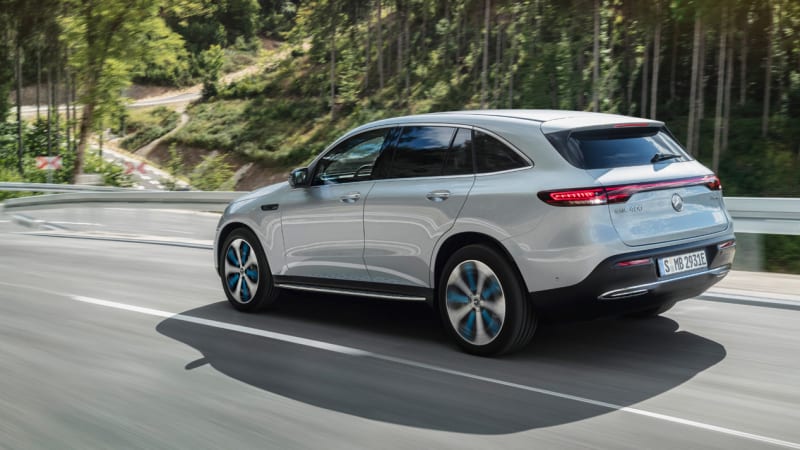The Mercedes-Benz EQC is where EV crossovers are headed
https://ift.tt/2LXrKRH
introduced its EQ sub-brand today with the EQC 400, an electric
with a claimed 200-mile range and 4.9-second 0-60 time, in Stockholm. It wears unique styling, but its overall dimensions are roughly equivalent to the
crossover. The design shares a strong resemblance to other
products, but there’s enough unique language – especially in the front end – to create some distance between the fully-electric and internal-combustion Mercedes families.
There aren’t many surprises inside or underneath the EQC, shown here in EQC 400 trim, but taken as a whole it seems like a solid offering in what’s going to be a crowded field in the very near future. For one, it doesn’t stray too far from Mercedes’ strengths. The EQC is instantly recognizable as a Mercedes, and has a safe and shapely crossover form factor. In particular, the interior exaggerates many of the distinctive contemporary Mercedes tropes, like the dual rectangular 10.25-inch media displays found in other cars, but floats them over the dashboard in a massive tablet-like panorama. Behind them are louvers, which Mercedes says are influenced by the heatsinks in high-end stereo amplifiers. The audiophile and technophile spaces share a lot of aesthetic overlap, so it’s good combination without being nearly as radical as the
‘s central display and otherwise minimalist dash.
Look more closely at the interior and you’ll see rose gold accents on the dash vents and in other places. Rose gold seems to be having a bit of a moment as a metallic finish of choice, and if you choose the Electric Art trim level, that’s what you’ll get. It’s warm, and provides some contrast to the predominantly blue accent lighting that has come to communicate to buyers that they’re driving an
.
The Mercedes MBUX infotainment system incorporates a number of EQ-specific features that are located in an EQ menu area. This includes a navigation system that optimizes routes for maximum range, routes you to a charger when needed, that sort of thing. Furthermore, in a nod to the smartphone market’s leadership in voice control interfaces, you can now access voice control by saying “Hey Mercedes” in the EQC. Mercedes says it’ll respond to natural speech. If you say, “Hey Mercedes, I’m cold”, it’ll apparently raise the temperature a degree. Interestingly, this isn’t a system that is purely server-based. Both the car’s onboard computer and a remote server interpret driver inputs, but if no internet connection is available, the onboard computer will do its best – whether this means it defaults back to requiring specific commands or uses its history of server interpretations stored locally to approximate a response is unclear. This is a feature we’re looking forward to trying, with and without a server connection.

Outside, there are massive Mercedes tri-star logos (which light up in certain markets) and a distinctive headlight design that look like an arc has been taken out of a regular GLC headlight. From that concavity, a band of piano black-finished material (presumably plastic) arcs underneath the grille to link the two headlights. Above (again, in some markets) a band of LEDs in the upper grille nearly links the boomerang-shaped LED running lights. Between trims (Electric Art and
Line have been announced), there are some differences in the upper and lower grille areas – either a series of lateral, metallic slats fill the spaces, or just two in the upper and an extra band of chrome outlining the lower grille (giving the effect of a fancy curled mustache).
Mechanically, things are pretty straightforward, as they are with most EVs. This is a dual-motor vehicle. The front motor, the individual output of which isn’t given, is set up for economy. Under low loads or when cruising, it’s primarily responsible for motivating the EQC. The rear motor is set up to provide performance, and presumably is of higher output. Total available system power is 402 horsepower and 564 pound-feet of torque. Mercedes says the EQC blends power continually to match desired performance and efficiency, and we’d guess power is also shifted between axles to maximize traction in inclement conditions.
The lithium-ion battery pack is modular. Two modules contain 48 cells, the other four have 72 cells, for a total of 384 cells and 80 kWh capacity. That puts it mid-pack among its competitors. The
e-tron SUV will have 95 kWh, the
i-Pace has 90 kWh, and the
iX3 will have “over 70 kWh”. Both the battery pack and the EQC will be built in Germany.

There are several driving modes, and most are familiar to Mercedes owners. The two specific EQ modes are Eco (maximizes economy) and Max Range (no explanation needed). The car also has a system called ECO Assist, which uses information from the route guidance, sign recognition, and speed limit data to suggest when the vehicle can coast to improve efficiency. The coasting cue is provided by a prompt on screen and a little diagram explaining why, indicating something like an upcoming intersection or hill. The accelerator has haptic feedback to keep you from jackrabbiting away from stops unnecessarily.
Of course, Mercedes also provides the EQC will a full suite of active safety features: Active Distance Assist Distronic, traffic jam following, Active Brake Assist, and an available Driver Assistance Package with improved brake assist, Evasive Steering Assist, Pre-Safe Plus, and Exit Warning Assist.
The EQC models (likely in EQC 400 guise, as there don’t seem to be any other variants on offer) will reach U.S.
in 2020. Pricing and finalized range numbers will be announced closer to the on-sale date.
Related Video:
Auto Blog
via Autoblog http://www.autoblog.com
September 4, 2018 at 01:08PM
